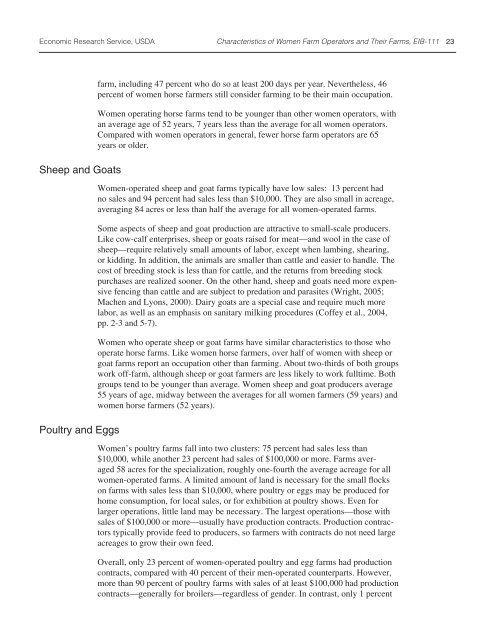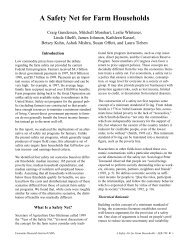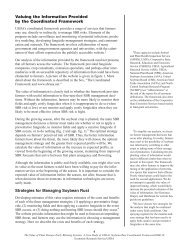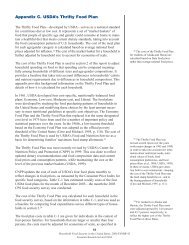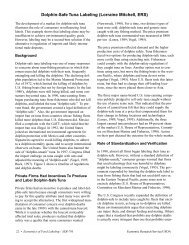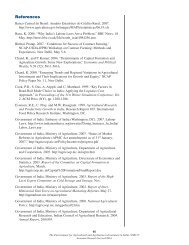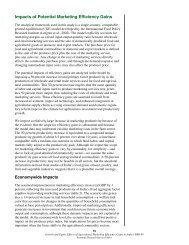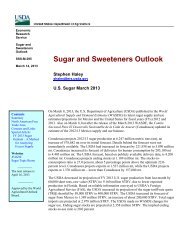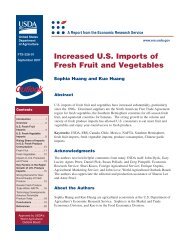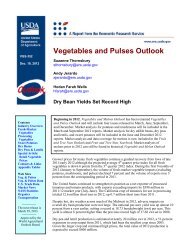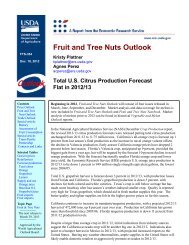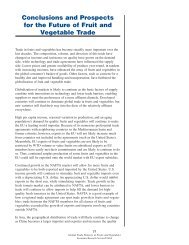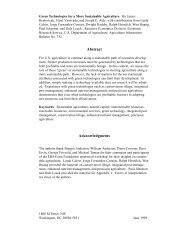Characteristics of Women Farm Operators and Their Farms
Characteristics of Women Farm Operators and Their Farms
Characteristics of Women Farm Operators and Their Farms
You also want an ePaper? Increase the reach of your titles
YUMPU automatically turns print PDFs into web optimized ePapers that Google loves.
Economic Research Service, USDA <strong>Characteristics</strong> <strong>of</strong> <strong>Women</strong> <strong>Farm</strong> <strong>Operators</strong> <strong>and</strong> <strong>Their</strong> <strong>Farm</strong>s, EIB-111 23<br />
Sheep <strong>and</strong> Goats<br />
Poultry <strong>and</strong> Eggs<br />
farm, including 47 percent who do so at least 200 days per year. Nevertheless, 46<br />
percent <strong>of</strong> women horse farmers still consider farming to be their main occupation.<br />
<strong>Women</strong> operating horse farms tend to be younger than other women operators, with<br />
an average age <strong>of</strong> 52 years, 7 years less than the average for all women operators.<br />
Compared with women operators in general, fewer horse farm operators are 65<br />
years or older.<br />
<strong>Women</strong>-operated sheep <strong>and</strong> goat farms typically have low sales: 13 percent had<br />
no sales <strong>and</strong> 94 percent had sales less than $10,000. They are also small in acreage,<br />
averaging 84 acres or less than half the average for all women-operated farms.<br />
Some aspects <strong>of</strong> sheep <strong>and</strong> goat production are attractive to small-scale producers.<br />
Like cow-calf enterprises, sheep or goats raised for meat—<strong>and</strong> wool in the case <strong>of</strong><br />
sheep—require relatively small amounts <strong>of</strong> labor, except when lambing, shearing,<br />
or kidding. In addition, the animals are smaller than cattle <strong>and</strong> easier to h<strong>and</strong>le. The<br />
cost <strong>of</strong> breeding stock is less than for cattle, <strong>and</strong> the returns from breeding stock<br />
purchases are realized sooner. On the other h<strong>and</strong>, sheep <strong>and</strong> goats need more expensive<br />
fencing than cattle <strong>and</strong> are subject to predation <strong>and</strong> parasites (Wright, 2005;<br />
Machen <strong>and</strong> Lyons, 2000). Dairy goats are a special case <strong>and</strong> require much more<br />
labor, as well as an emphasis on sanitary milking procedures (C<strong>of</strong>fey et al., 2004,<br />
pp. 2-3 <strong>and</strong> 5-7).<br />
<strong>Women</strong> who operate sheep or goat farms have similar characteristics to those who<br />
operate horse farms. Like women horse farmers, over half <strong>of</strong> women with sheep or<br />
goat farms report an occupation other than farming. About two-thirds <strong>of</strong> both groups<br />
work <strong>of</strong>f-farm, although sheep or goat farmers are less likely to work fulltime. Both<br />
groups tend to be younger than average. <strong>Women</strong> sheep <strong>and</strong> goat producers average<br />
55 years <strong>of</strong> age, midway between the averages for all women farmers (59 years) <strong>and</strong><br />
women horse farmers (52 years).<br />
<strong>Women</strong>’s poultry farms fall into two clusters: 75 percent had sales less than<br />
$10,000, while another 23 percent had sales <strong>of</strong> $100,000 or more. <strong>Farm</strong>s averaged<br />
58 acres for the specialization, roughly one-fourth the average acreage for all<br />
women-operated farms. A limited amount <strong>of</strong> l<strong>and</strong> is necessary for the small flocks<br />
on farms with sales less than $10,000, where poultry or eggs may be produced for<br />
home consumption, for local sales, or for exhibition at poultry shows. Even for<br />
larger operations, little l<strong>and</strong> may be necessary. The largest operations—those with<br />
sales <strong>of</strong> $100,000 or more—usually have production contracts. Production contractors<br />
typically provide feed to producers, so farmers with contracts do not need large<br />
acreages to grow their own feed.<br />
Overall, only 23 percent <strong>of</strong> women-operated poultry <strong>and</strong> egg farms had production<br />
contracts, compared with 40 percent <strong>of</strong> their men-operated counterparts. However,<br />
more than 90 percent <strong>of</strong> poultry farms with sales <strong>of</strong> at least $100,000 had production<br />
contracts—generally for broilers—regardless <strong>of</strong> gender. In contrast, only 1 percent


